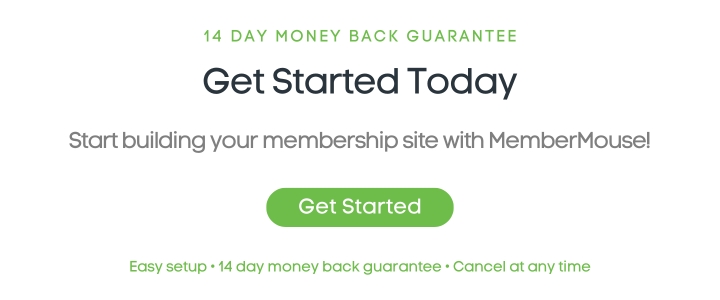How To Start A Successful Stock Trading School In 2023
Are you a finance expert? Do you have years of experience trading stocks or options? Have you ever thought about sharing your knowledge and expertise with a larger audience?
If so, you might be the perfect person to start a financial education business – like a stock trading school or portfolio management membership.
I've personally worked with dozens of online entrepreneurs who've built financial education platforms. And in this article, I'll share what I know about building these kinds of online businesses with you.
With the information you'll learn here, you'll be ready to hit the ground running when you start building your own financial education business.
Let's dive in.

Who Do You Want To Serve?
The first thing you'll want to nail down when planning your financial education site is who you plan to serve. Who is your audience? Who do you want to work with?
Do you want to work with people who've never bought a single stock before? Or do you want to work with investors who are ready to debate the finer points of Fibonacci retracements?
When you know precisely who you want to work with, you'll get a lot of clarity around things like what your offer will be, your pricing model, and how much you can charge.
For example, a brand-new investor who doesn't have an E*TRADE account needs a lot more support and education than the guy with four monitors and an annual subscription to the Motley Fool.
I encourage you to spend as much time as necessary identifying your audience. Don't skip this phase. I promise it will make all your downstream decisions much easier. If you need a starting point, consider going through a customer avatar creation process like this one from Digital Marketer.
Once you know your target audience, it's time to move to the next step and solidify your offer.

What Do You Plan To Offer?
Now that you know who you want to serve inside your financial education site, it's time to think strategically about your offer.
Let's imagine that you plan on serving brand-new investors. Here's a basic blueprint of a product you could create for them:
- A 30-day course that helps a new investor upgrade their money mindset
- A video library that shows a new investor how to open up all the key accounts they'll need
- An event calendar where your students can RSVP for your weekly group coaching calls
- Access to a shared community area where students can share their wins and get help with their struggles
An offer like this can be designed to help your students overcome the biggest challenges you know they'll face in their journeys to becoming profitable investors. We'll talk more about pricing and payment models in the next section. But for now, I'd love for you to think about whether this offer would work best as a one-time payment or a recurring subscription.
“The closer you can align the way you package your value to the goal that your customer has, the more likely your customer is to trust you for the long term.”
Now, let's compare the previous offer for beginners to one that's designed for the advanced trader. Here's an offer that could work well for these students:
- Private access to a Slack channel where you and your team are always available when the markets are open to strategize daily trades
- A 10-minute market update video that gets sent out to all students at 9:00am EST each day
- A 7-module course library with advanced trainings like how to use Sierra Chart to plan a crude oil futures position
- 1 monthly 1:1 coaching call with you to analyze your student's portfolio
As I'm sure you can see, this type of offer is much better suited for advanced students.
Now, let's revisit the question I posed to you above. Do you think this offer for more experienced traders would work best as a one-time payment or a recurring subscription?
I promise I won't keep you in suspense any longer. In this next section, we'll discuss the best way to think about pricing for your financial education platform.

Let’s Figure Out Your Pricing & Payment Model
When it comes to solidifying the pricing and payment model for your financial education business, you essentially have two options: one-time purchases or recurring payments.
One-time purchases are perfect for courses. Once your student buys your program, they’ll typically retain access to it for life.
A recurring purchase is best for a membership or subscription. Your students pay a fee each month for access to your products and services.
So which model should you choose for your business?
Here's how I recommend you think about it:
A one-time purchase offer is ideal for helping someone learn a new skill set, achieve an initial transformation, or give them limited training and education.
Remember our example offer for beginners investors above? I would argue that this product is best offered as a one-time purchase product. Here's why:
One-Time Purchases For Financial Education Courses:
Someone who is brand-new to investing needs a lot of training and education. They are going to have a ton of questions, and likely experience a lot of friction in their journey. It takes sustained time, attention, and energy to consume all of the content they'll need to get to the point where they're ready to start investing.
Because of this, it makes sense to require a larger up-front investment on their part. An investment of say $997 requires a certain level of commitment to personal growth. And when someone makes that investment, they are far more likely to value the course they've bought and follow through with your program.
If you were to package this offer as a subscription instead – let's say at $97 per month – when life gets hard and your student experiences friction and resistance, they might be tempted to cancel after 1, 2, or 3 months. Not only does this hurt your business, it actually hurts the progress of your students as well.
When you offer a product like this as a one-time purchase instead of a subscription, you ensure that your students keep access to the content they've paid for even when they may not feel like going through it. Then, even after moments of frustration and resistance, they'll be able to return to your course and continue their journey.
The Subscription Model For Financial Education Sites:
Now let's look at the sort of offers that are best for recurring pricing models like a subscription.
A recurring payment model is best for when your customers have a “forever problem” and you can provide a “forever solution.” This idea comes from membership and subscription expert Robbie Kellman Baxter. If you'd like to listen to a deep dive on this topic, I highly recommend you check out this podcast episode with her.
In the case of our advanced traders, they have a forever problem: the need for daily advice, guidance, and strategy about the chaotic movements of the stock market. Even the most advanced and experienced traders I've worked with continue to be in “pits” with other pros. It seems that isolation is a dangerous thing for traders, because of the volatile nature of the market.
As a financial expert yourself, you can offer your customers a forever solution to their problem: daily advice, guidance, and strategy about investing. This is an answer to a problem that won't go away for as long as they are actively trading.
The reason this offer is perfectly suited for a recurring revenue pricing model is that the “product” you're delivering to them is alive, dynamic, and unlimited. Look back on the offer for advanced traders, you're giving them daily market update videos, access to a private Slack channel, and monthly individual coaching. These things trend towards services, while the course for beginners trends towards a pure product. As long as you are providing these services to your students, they should be paying for them.
Because this offer for advanced traders is designed to help your students earn more money trading, you could even price this product based on the ROI you honestly think you can help them achieve. If someone signs up for this membership, are you confident you could help them earn at least $3,000 per month trading? If so, you could charge $300 per month so that you can help them 10x their investment.
How To Think Strategically About Your Pricing:
The reason you might not want to offer this product as a one-time purchase, is that you could easily be underpaid for what you deliver to your students.
Let's say that you decide to forgo the subscription model for this product and charge a one-time, $3,000 fee. If someone sticks around in your membership for 3 years, each video you send them, and each coaching session they have essentially gets cheaper and cheaper.
If you deliver 3 years worth of videos and coaching to a student, they've only ended up paying ~$1,000 per year for your services. On the flip side, if you had adopted the $300 per month subscription, this same student would have paid you $10,800 for those same three years. I know which path I'd prefer.

What Assets Do You Already Have?
Before we actually get to the building stage of you financial education platform, let's consider something. What are your existing assets?
Are you truly starting from scratch, with no content, no website, no audience? Or, do you already have a website, or a podcast, or a YouTube channel, or a small-but-mighty following on social media? The assets you've already created can have a big impact on your next steps.
For example, let's say that you already have a WordPress blog where you've been sharing your ideas about investing for a few years. If this is the case, it might make the most sense for you to add a private content area to your existing website. There are a number of ways to do this, but the most popular was is to use a WordPress membership plugin or learning management system to protect your private content and collect payments from your customers.
On the other hand, if all you have is a YouTube channel, it might not make sense for you to build a WordPress site from scratch just to host your courses or community. In this instance, it might be better for you to test your idea with a hosted learning management or community tool like Teachable or Circle.
The important thing for you to do is take stock of your existing assets and think about how you can build on what you've already done.
Once you've done that, it's time to plan out how you'll bring your big idea to life.

It’s Time To Choose Your Platform
When it comes to creating a membership site, online course, or group program, you basically have two options when it comes to deciding where you'll build your platform: WordPress or a hosted solution.
Building With WordPress
If you decide to go the WordPress route, this will involve buying a domain name, getting a host, choosing a theme, and stocking up on plugins that will support your business.
An example plugin stack for a financial education membership site or online course could look like this:
- Elementor for your theme and page builder
- MemberMouse for your content protection and payment collection
- LearnDash for your course modules and progress quizzes
- bbPress for your community area
The great thing about going the WordPress route is that you have full control over the tools you use and unlimited flexibility to create your vision. Basically, the WordPress ethos supports this idea: “If you can dream it, you can do it.” While WordPress itself is technically free, you will pay fees for hosting, themes, plugins, and more.
That said, the greatest strength of WordPress is also sort of its weakness. Because it is so flexible and customizable, it's up to you to plan, design, and assemble your vision. This isn't a “plug and play” approach that you can get up and running in an hour. Plus, the more tools you use for your online business, the more you'll need to keep track of.
Choosing A Hosted Tool
If you choose not to go the WordPress route, you're faced with finding the right hosted tool for the job. There are dozens of these tools out there. And they're all designed to support different business models. You'll need to do your own research to find the right tool for your business. But, here's a list of the most commonly used tools and their use-cases:
- Teachable for online courses
- Kajabi for an “all in one” website, email, and online course tool
- Mighty Networks for community and events
While these tools are very powerful and practical, they do come with their own limitations. What I've seen happen time and time again is that entrepreneurs start their businesses with one of these hosted tools, and use it until they hit an insurmountable limitation. Because these tools are hosted, managed, and developed by big companies, they can't be customized to fit the needs of your specific business.
Just like with WordPress, the strength of these tools is also their weakness. While a hosted tool may be more convenient at first, it could end up limiting the long-term evolution of your business. If and when this happens, you'll need to look at migrating your business to another solution. This can be an intense process that requires a lot of time and money to complete.
How Do You Decide?
I know this is a lot of information to process, so here's an easy exercise that'll help you determine which approach is best for you:
Imagine that your financial education site is up and running. Over the weekend, you get a flash of inspiration for a new idea for your business. On Monday morning, you sit down at your computer and start building it. But when you try and build your idea, you realize that your membership or online course tool won't let you do it. You'll either have to adjust your idea to fit within the limitations of your tech stack, or abandon it.
Think about this scenario for a second. Would this situation frustrate you? Would it totally kill your motivation if you weren't able to execute your new ideas as they came up? Or, would you feel fine letting go of this idea because you know the ease and convenience your tech stack provides you is worth sacrificing a bit on your ideas.
If this scenario would drive you nuts, I'd recommend going the WordPress route. With WordPress, even though things might seem a bit manual, there is always a way to create your ideas. You're much more in control of your tech environment than with a host tool.
But if this scenario doesn't bother you — if in fact you want to spend as little time as possible thinking about technology — I'd recommend going the hosted route and choosing a tool like Teachable or Mighty Networks.
At the end of the day, you will need to research which option will be best for your financial education site. But I hope this section has been helpful in clarifying your thinking around the topic.

Final Thoughts On Financial Education Sites
We hope this article on how to build a financial education business, like a stock trading school, has been helpful for you.
If you’d like to learn more about how you can build a financial education platform you can be proud of, you can check out this helpful resource.
And if you'd like to hear a conversation with an entrepreneur who's built a very successful financial education course and membership site, you should definitely give this conversation featuring George Papazov of TRADEPRO Academy a listen.
Matt Brown
Over the past 6 years, Matt Brown has worked closely with some of the world's most successful membership and online course entrepreneurs. He's seen first hand what works – and what doesn't – when it comes to starting, building, and growing online businesses. On top of that, Matt was responsible for screening all the guests we've had on the Subscription Entrepreneur podcast. This allowed him to hear the best membership marketing and growth strategies from top authors and experts. Now, he shares everything he learns with you here on the MemberMouse blog. Subscribe today so you can discover cutting-edge strategies that can help you grow your membership, subscription, and online course business.
 Blog
Blog Podcast
Podcast Support
Support Customer Login
Customer Login









